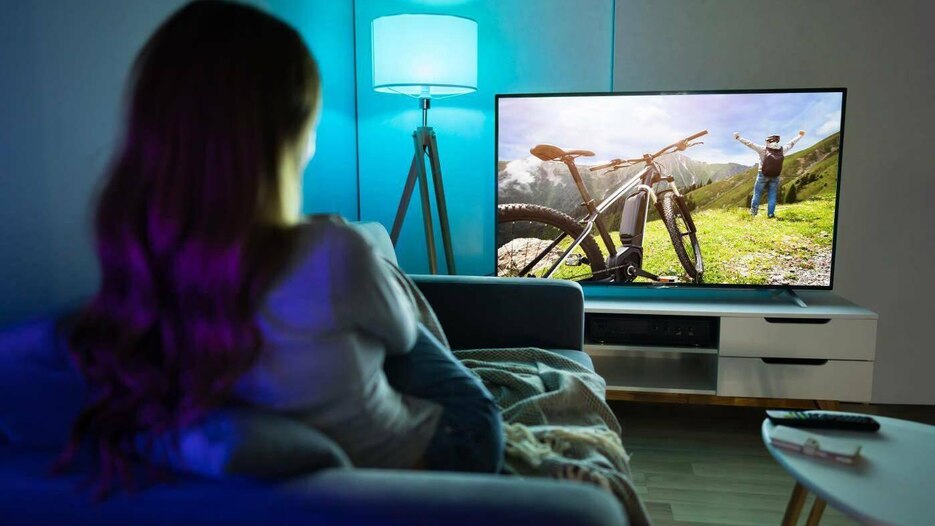Televisions, computers, game consoles, language assistants – more and more devices are permanently in use in your home. The power consumption for home entertainment increases accordingly, and with it the energy costs.
The dealer may pay a commission for links on this page, eg for links marked with or green underlining. More info.
Power consumption: With a TV, screen size and brightness are decisive
The larger the screen diagonal of the television, the more electricity is consumed. The age of the device, the technology used (tube, plasma, LCD, LED or OLED) and the brightness setting also play an important role.
A 32-inch widescreen LCD TV is approximately 200 watts. Depending on their size, modern LED and OLED televisions have a power consumption of 40 watts to 130 watts.
The power consumption of a tube television is usually lower than that of modern flat screen TVs of the same size – however, most older televisions are only available with small screen diagonals.
Less power is consumed in stand-by mode. Here the devices are between 0.15 watts and 0.50 watts.
Tip: If you are looking for a new television, buy a device with an integrated tuner, as this hardly uses any more energy. TVs that do not offer these functions, on the other hand, increase electricity costs due to the additional device. Our TV purchase advice will help you with your selection.
Detailed information on the power consumption of TVs can be found here

Power consumption for home entertainment devices: When it comes to TVs, screen size and brightness play a particularly important role
imago images / Panthermedia
How much power consumption is normal?
A two-person household in Germany consumes an average of 2,000 kilowatt hours (kWh) of electricity per year in an apartment building. For a single-family house, the consumption is around 2800 kWh. These values are without the treatment of hot water.
How many kWh is normal for 2 people?
In an apartment building, 1,800 to 2,800 kWh is the normal value. If there is electric water heating, the value can increase by 900 kWh. In a family home, the normal average is 3,600 kWh including hot water.
What is included in power consumption?
All electrical devices require electricity. Starting with the lighting, through the stove to the PC. If these devices are in operation, this is referred to as power consumption.
Apple TV: How much power does the device use?
The Apple TV connects to the TV to play media content over the Internet or over Wi-Fi. When the set-top box is not in use, it goes into stand-by mode, which also consumes power.
The consumption for playing music is 2.1 watts. If you stream a film or play a game, the consumption varies between 2.6 watts and 4.9 watts.
1.4 watts are consumed in stand-by mode. If the Apple TV is in operation for two hours a day and rests for the rest of the time, it costs just under EUR 5 a year for stand-by mode.
Tip: Use one for standby devices individually switchable power strip and switch off the power supply when Apple TV & Co. are not in operation. This is an easy way to save money.
Detailed information on the power consumption of Apple TV can be found here
High power consumption: language assistants are always in use
Language assistants such as Siri, Alexa or Google Home are always ready for use and run around the clock in stand-by mode.
This means that these devices draw between 1.5 and 3 watts of power, even when they are inactive.
Starting at 40 cents per kilowatt hour, electricity costs fall between when you are on stand-by5 EUR and 11 EUR per year.
If voice commands are used and music is listened to for two hours a day or films are streamed, consumption increases to up to 9 watts. The annual costs increase accordingly.
Detailed information on the power consumption of Amazon Alexa can be found here

Language assistants consume electricity, especially in stand-by mode.
imago images / Panthermedia
Sonos speakers: power consumption at a glance
The power consumption of the Sonos speakers varies depending on the model.
The PLAY 5 (Gen. 2) model has the lowest consumption in stand-by mode with 2.2 watts. The AMP model consumes the most energy at 6.8 watts. Here you come to electricity costs between EUR 7 and EUR 22 per year if the device is in stand-by mode for 23 hours.
The speakers draw about 0.3 watts more with a LAN connection. According to the manufacturer, the devices consume 1 watt less when the WLAN is switched off than when the WLAN is switched on.
How high the power consumption is in operation depends on the model and the volume. The values here are between 7.3 watts and 18.5 watts.
Tip:Turn off the Sonos speaker when you don’t need it. So there are no energy costs for the standby mode.
Detailed information on the power consumption of Sonos can be found here
Notebook: The amount of electricity costs depends on various factors
How much power your notebook consumes depends on various factors. It depends, among other things, on the computing power and the processor type. The power consumption of the power pack serves as a guide for the power consumption.
Gaming notebooks have more power and a power consumption of up to 300 watts. For a standard notebook, the value is between 30 and 150 watts.
Consumption is reduced in stand-by mode. Depending on the device, this is between 2 watts and 15 watts.
You can also calculate the power consumption of your notebook using the formula power consumption in kW x duration of use in hours x electricity price in euros = electricity costs per day.
If your notebook has a power consumption of 50 watts, that is 0.05 kilowatts: 0.05 x 8 x 0.40 = 0.16 cents/day. If you use your notebook five days a week, the annual costs will be EUR 41.60.
Tip: Unplug the power adapter from the outlet when not in use. Many power supplies have an LED and therefore still consume a small amount of electricity.
Detailed information on the power consumption of notebooks can be found here
This is how much electricity a PC uses: Calculating costs made easy
Similar to a notebook, the power consumption of a PC also depends on use, performance and peripheral devices such as printers, monitors or sound systems.
A classic desktop computer consumes around 135 watts, almost three times as much as a standard notebook.
If you apply the above rule of thumb, you would end up with energy costs of EUR 112.32 per year for the same period of use.
In order to determine the power consumption more precisely, you need to know the built-in components of your PC. The hardware can be read out with on-board resources.
Detailed information on measuring the power consumption on the PC can be found here

The power consumption of PCs and notebooks sometimes differs noticeably from each other.
imago images / MASKOT
Energy costs of the PlayStation: This costs the operation of the game console
The energy costs incurred vary depending on the model. Please note that all game consoles run permanently in stand-by mode and therefore consume electricity even when not in use.
The original PS3 consumes 1.22 watts in standby mode. If you are in the home menu, the consumption is 170 watts. Watch films or stream videos via YouTube, consumption reaches 180 watts. For complex games, the console requires 200 watts.
The successor model PS3 Slim is more economical. In stand-by mode, the consumption is 0.36 watts. In the main menu, the games console comes up to 75 watts. When playing movies or YouTube, it is 80 watts. Games are around 100 watts.
The PS4 consumes between 80 and 90 watts in the menu. Playing videos consumes up to 100 watts and during gaming the values are between 140 and 150 watts.
Detailed information on the power consumption of the PS4 can be found here
xBox One: Power consumption of the console in operation and standby
The following information is a guide. The power consumption increases especially with graphically complex games.
If you are in the main menu, the power consumption is 69 watts. If you install a game on the Xbox One, the consumption increases to up to 70 watts.
Approximately 65 watts are required for film playback on Blu-ray. The power consumption for gaming varies. Here you can calculate between 120 watts and 140 watts.
In stand-by mode, the consumption is 15 watts. This value is high due to voice control, permanent internet connection and automatic updates.
Tip: If the Xbox is permanently on standby, this can result in an additional charge of up to EUR 35 per year. It may therefore be worth turning off the game console completely if you don’t want automatic updates.
Detailed information on the power consumption of the XBOX One S can be found here
Nintendo Wii U: Lowest energy consumption among game consoles
In contrast to the Xbox One, the Wii U is technically weaker and therefore consumes less power.
Depending on the game or when streaming videos, the values here can be slightly higher or lower. Average consumption is 34 watts.
For example, if you play four times a week for four hours, the cost factor is EUR 11.32 per year.
0.4 watts are consumed in stand-by mode. Streaming a movie uses 29 watts.
Detailed information on the power consumption of the Nintendo Wii U can be found here
Calculate the power consumption of your home entertainment: here it is
If you would like to calculate the consumption and electricity costs of your own devices more precisely, you can use our calculator. Simply fill out all fields accordingly:
How much electricity does my home entertainment use?
Here you can easily calculate the power consumption of your device.
A notice: The values already entered are average values.
Result:
Other readers also interested:
